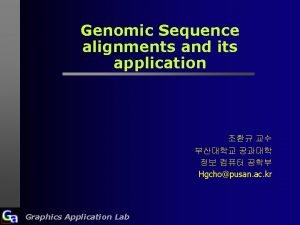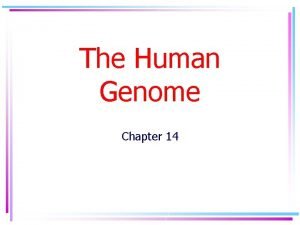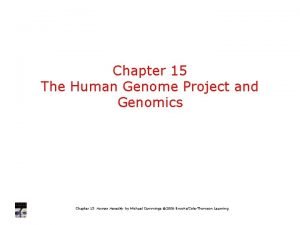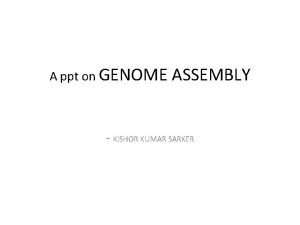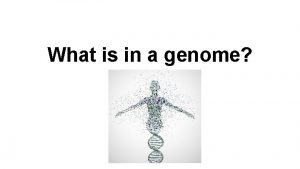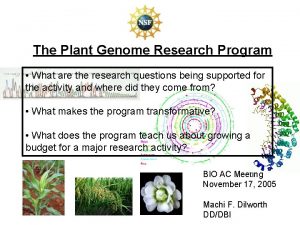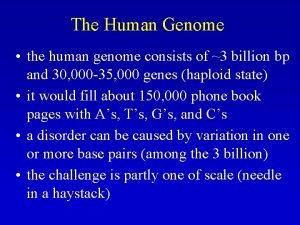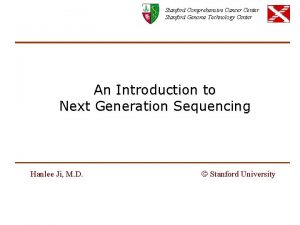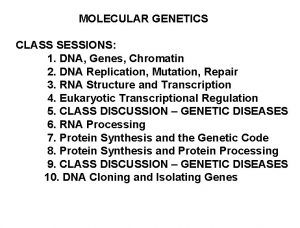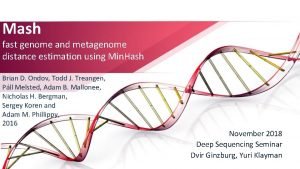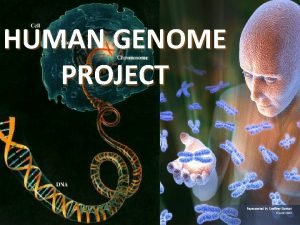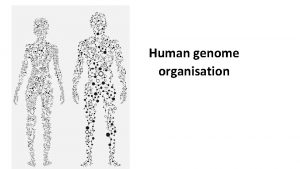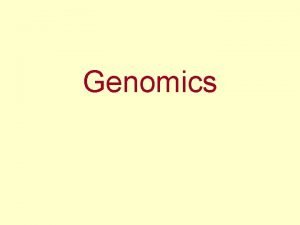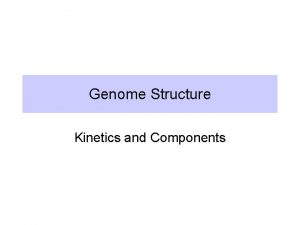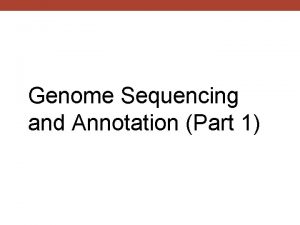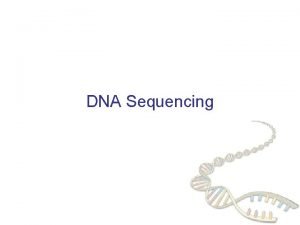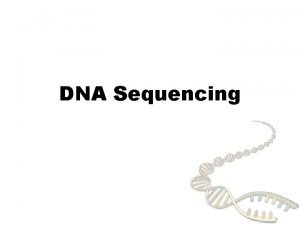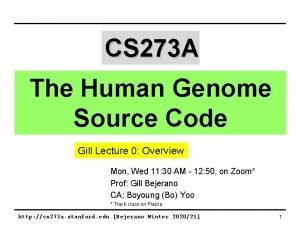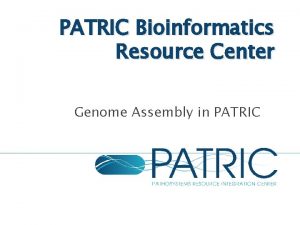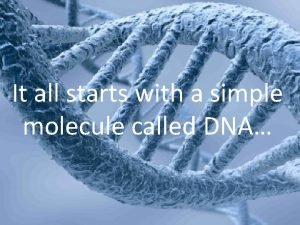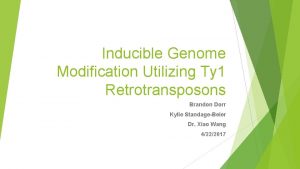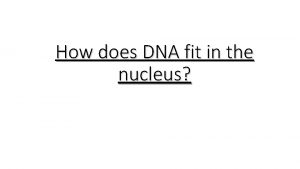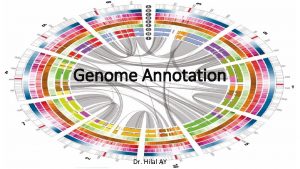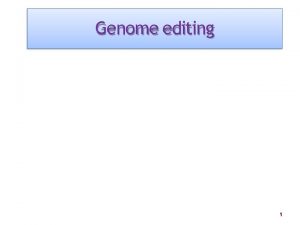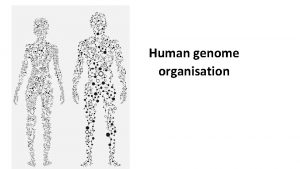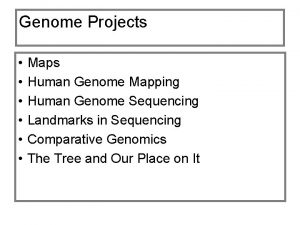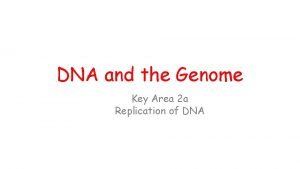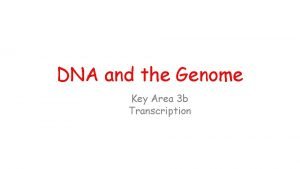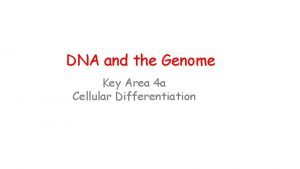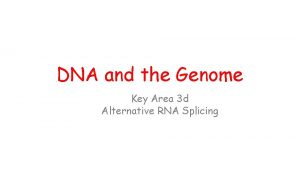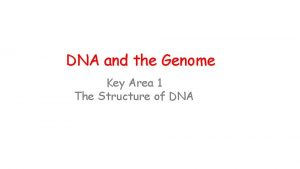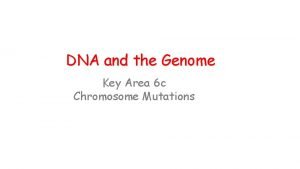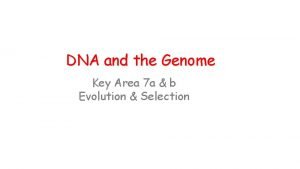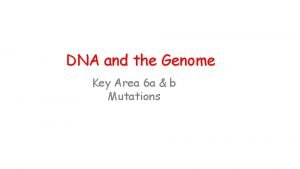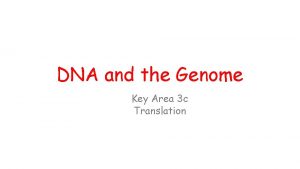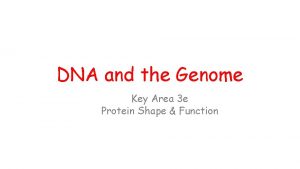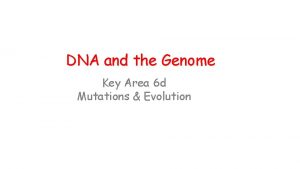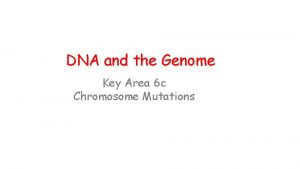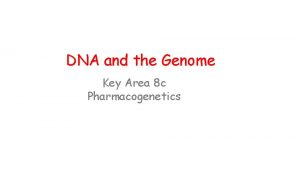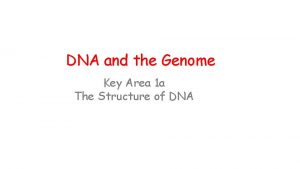DNA and the Genome Key Area 3 a






























- Slides: 30

DNA and the Genome Key Area 3 a Gene Expression RNA

Learning Intentions By the end of this topic you should be able to: Explain why only a fraction of genes in a cell are expressed State which processes are regulated to control gene expression

Learning Intentions Structure and functions of RNA Name the molecules in a RNA nucleotide and identify them in a diagram Name the type of bond on the backbone of the RNA molecule Give the names of the 4 RNA bases Describe the base pairing rule for RNA bases Describe 3 differences between RNA and DNA molecules State what m. RNA is and describe its role Describe the structure of a ribosome State what t. RNA is and describe its role

A little revision…. What is inheritance? • All characteristics of living things are determined by genetic information. • This is carried on the chromosomes found in the nucleus of all cells • Each body cell has 2 matching sets of chromosomes • Offspring receive half their genetic information from each parent

Genes • Each chromosome carries information in units called genes • The gene for each characteristic exists in 2 or more forms called alleles • One form is usually dominant, this is represented by a capital letter e. g. ‘B’ • The other form is recessive, this is represented by the small letter e. g. ‘b’

Definitions • The genotype is the type of alleles an organism carries • The phenotype is what the organism looks like (and its chemical state) and is determined by the genotype • The dominant allele is the one that always shows even if the recessive allele is present • The recessive allele only shows if both alleles are the recessive form

Role of Genes The structure and function of all cells are determined by their genes. Each gene on a strand of DNA codes for each protein that the cell requires. To prevent resources being wasted only a fraction of the genes within a cell are expressed Enzyme induction is the name for the process of switching on a gene when the protein is required. Image source: library. thinkquest. org

As an organism develops, tissues such as muscle, liver or blood become differentiated from each other. Each tissue consists of specialised cells which only carry out certain functions.

Although a specialised cell has a complete set of the organism's genes……

……. only those genes needed for its specialised functions are switched on. All other genes are switched off!

Genes switched on in ALL cells Genes that code for vital metabolites necessary for basic life processes Genes switched on in SOME cells Genes that are only switched on in certain differentiated cells. e. g. • enzymes needed for aerobic respiration • insulin made by pancreas cells • proteins in plasma membrane • antibody production • Proteins needed to make cell organelles • Production of digestive enzymes • Production of keratin

Genetic control of Differentiation: Blood as an example All human cells contain the genes that allow them to become blood cells. The type of cell they become depends on the genes that are switched on during differentiation (when stem cells undergo mitosis and develop into specialised cells). Although red blood cells and white blood cells contain all of the same genes, they have different genes switched on and off. Red blood cells have the gene for the production of haemoglobin switched on. Some white blood cells have the gene for the production of antibodies switched on

Transcription and Translation Gene expression involves the TRANSCRIPTION and TRANSLATION of DNA sequences and involve 3 types of RNA: • Messenger Ribonucleic Acid (m. RNA) • Transfer Ribonucleic Acid (t. RNA) • Ribosomal Ribonucleic Acid (r. RNA)

Structure and Function of RNAs

Overview

RNA DNA is one type of nucleic acid but there is another type called Ribonucleic Acid (RNA). There are 3 different types of RNA: 1. m. RNA (messenger RNA) 2. t. RNA (transfer RNA) 3. r. RNA (ribosomal RNA) All 3 have the same nucleotide structure and are involved in transcription and translation

RNA Nucleotides RNA is single stranded and is composed of nucleotides (see below) RNA nucleotides differ from DNA nucleotides in 3 ways: 1. RNA is single stranded (DNA is double stranded) 2. RNA has ribose sugar (DNA has deoxyribose sugar) 3. RNA has the base uracil (DNA has thymine) phosphate 5’ end base 3’ end ribose sugar


The base is still attached to carbon number 1 (C 1) and the phosphate to carbon number 5 (C 5) When forming the sugar phosphate backbone, the phosphate still attaches from C 5 to C 3 of next nucleotide as shown Notice the U instead of the T

m. RNA Protein synthesis occurs in the cell cytoplasm at the ribosomes but as the DNA cannot leave the nucleus a copy of the info on DNA must be made m. RNA carries a copy of the DNA code from the nucleus to the ribosome during transcription m. RNA is transcribed from DNA in the nucleus and translated into proteins by the ribosomes

DNA determines inherited characteristics An organisms inherited characteristics (e. g eye colour) are determined by the genetic information contained by the DNA. The information present in DNA takes the form of a code language called the ‘genetic code. ’ The sequence of bases can be thought of as ‘codewords. ’

• The sequence of bases in a gene provides the genetic code for proteins • A sequence of 3 DNA bases (triplet) codes for one amino acid (remember, proteins are made from long chains of amino acids) • Each triplet allows 64 (4³) possible combinations.

Codons The basic unit of the genetic code is called a codon. This is a triplet of bases on the m. RNA which has been copied from the DNA. Image source: evolution. berkeley. edu

Codons Each triplet codes for one of 20 different amino acids. The combination of amino acids determines which protein is produced. Image source: science. howstuffworks. com


r. RNA When the DNA is transcribed into m. RNA, the m. RNA leaves the nucleus, enters the cytoplasm and travels to the ribosome where it will be translated into the protein Ribosomes are themselves made of protein combined with ribosomal RNA (r. RNA). The ribosomal RNAs form two subunits, the large subunit (LSU) and small subunit (SSU). m. RNA is sandwiched between the small and large subunits and the ribosome catalyzes the formation of a peptide bond between the 2 amino acids that are contained in the r. RNA


t. RNA When the m. RNA reaches the ribosome it is translated into proteins with the help of transfer RNA (t. RNA), which are found in the cytoplasm (and ribosome). Each t. RNA transports specific amino acids to the ribosome.

The t. RNA folds due to complimentary base pairing in such a way that they have a specific triplet of bases exposed at one end called an anticodon. They also have an attachment site for a specific amino acid at the other end t. RNA

Nucleus DNA Overview of gene expression AGAGGTTGACGAA T CT CCAACTGCTT Transcription m. RNA U CU CCAACUGCUU codon Ribosome Translation Protein ser pro thr ala
 Semi-global alignment
Semi-global alignment Sickle cell karyotype
Sickle cell karyotype Human genome project
Human genome project Coding dna and non coding dna
Coding dna and non coding dna Dna polymerase function in dna replication
Dna polymerase function in dna replication Bioflix activity dna replication dna replication diagram
Bioflix activity dna replication dna replication diagram Enzyme involved in dna replication
Enzyme involved in dna replication Chapter 11 dna and genes
Chapter 11 dna and genes Genome assembly
Genome assembly What are key activities in a business model
What are key activities in a business model Business model canvas tripadvisor
Business model canvas tripadvisor Dna structure and replication packet answer key
Dna structure and replication packet answer key Genome
Genome Plant genome research program
Plant genome research program The human genome consists of
The human genome consists of Stanford
Stanford Human genome size
Human genome size Mash distance
Mash distance Human genome size
Human genome size Future of human genome project
Future of human genome project Satellite dna
Satellite dna Per partes
Per partes Repeated sequences
Repeated sequences Shotgun sequencing
Shotgun sequencing Shotgun sequencing
Shotgun sequencing Dna
Dna Human genome project source code
Human genome project source code Patric bioinformatics
Patric bioinformatics National human genome research institute
National human genome research institute Genome modification ustaz auni
Genome modification ustaz auni National human genome research institute
National human genome research institute
